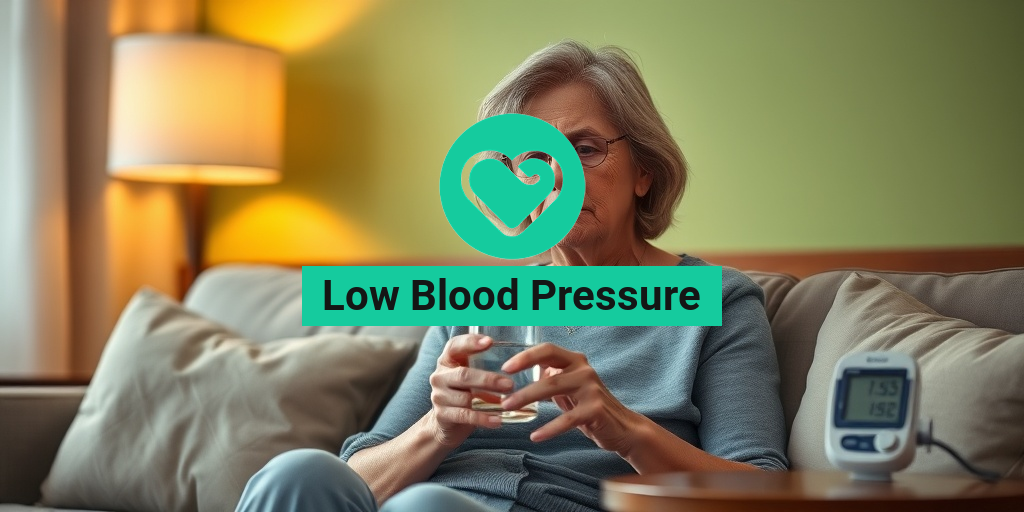What Is Low Blood Pressure?
Low blood pressure, medically known as hypotension, occurs when the blood pressure in your arteries is lower than normal. While many people associate high blood pressure with health risks, low blood pressure can also pose significant health challenges. Blood pressure is measured in millimeters of mercury (mmHg) and is expressed with two numbers: systolic (the pressure when your heart beats) over diastolic (the pressure when your heart rests between beats). A typical reading for normal blood pressure is around 120/80 mmHg. Generally, a reading below 90/60 mmHg is considered low blood pressure.
Understanding Blood Pressure Ranges
To better understand low blood pressure, it’s essential to know the different blood pressure ranges:
- Normal: Less than 120/80 mmHg
- Elevated: 120-129/less than 80 mmHg
- Hypertension Stage 1: 130-139/80-89 mmHg
- Hypertension Stage 2: 140 or higher/90 or higher mmHg
- Hypotension: Less than 90/60 mmHg
Low blood pressure can be a normal condition for some individuals, especially athletes or those who are physically fit. However, for others, it can lead to various health issues, particularly if it drops suddenly or is accompanied by symptoms.
Causes of Low Blood Pressure
Several factors can contribute to low blood pressure, including:
- Dehydration: When your body loses more water than it takes in, it can lead to low blood volume, causing a drop in blood pressure.
- Heart Problems: Certain heart conditions can affect your heart’s ability to pump blood effectively, leading to low blood pressure.
- Endocrine Issues: Disorders of the adrenal glands, such as Addison’s disease, can disrupt hormone levels and lead to low blood pressure.
- Severe Infection: Sepsis, a severe infection that spreads throughout the body, can cause a dangerous drop in blood pressure.
- Blood Loss: Losing a significant amount of blood, whether from an injury or internal bleeding, can reduce blood volume and lead to hypotension.
Low Blood Pressure Symptoms
Recognizing the symptoms of low blood pressure is crucial for timely intervention. While some individuals may not experience any symptoms, others may face various challenges. Common symptoms include:
Common Symptoms
- Dizziness or Lightheadedness: This is often the first sign of low blood pressure, especially when standing up quickly.
- Fainting: In severe cases, low blood pressure can lead to fainting spells.
- Fatigue: Chronic low blood pressure can result in persistent fatigue and weakness.
- Nausea: Some individuals may experience nausea or an upset stomach.
- Blurred Vision: Low blood pressure can affect vision, causing it to become blurry.
When to Seek Medical Attention
If you experience symptoms of low blood pressure, especially if they are sudden or severe, it’s essential to consult a healthcare professional. Persistent low blood pressure can lead to complications, including shock, which is a medical emergency. If you’re pregnant and experiencing low blood pressure, it’s crucial to discuss this with your healthcare provider, as it can affect both you and your baby.
For more information on managing low blood pressure and understanding its implications, consider visiting Yesil Health AI, a valuable resource for evidence-based health answers.
In conclusion, while low blood pressure can be a benign condition for some, it’s essential to be aware of its symptoms and potential causes. Staying informed and proactive about your health can help you manage low blood pressure effectively. 🌟

Causes of Low Blood Pressure
Low blood pressure, also known as hypotension, can occur for a variety of reasons. Understanding the underlying causes is essential for managing this condition effectively. Here are some common causes of low blood pressure:
1. Dehydration
When your body loses more water than it takes in, it can lead to dehydration. This can occur due to excessive sweating, vomiting, diarrhea, or not drinking enough fluids. Dehydration reduces blood volume, which can cause low blood pressure.
2. Heart Problems
Several heart conditions can lead to low blood pressure, including:
- Heart attack: Damage to the heart muscle can reduce its ability to pump blood effectively.
- Heart failure: The heart may not pump enough blood to meet the body’s needs.
- Bradycardia: An unusually slow heart rate can lead to insufficient blood flow.
3. Endocrine Disorders
Hormonal imbalances can also contribute to low blood pressure. Conditions such as Addison’s disease, where the adrenal glands do not produce enough hormones, can lead to hypotension. Similarly, issues with the thyroid gland can affect blood pressure levels.
4. Blood Loss
Significant blood loss from an injury or internal bleeding reduces the amount of blood in your body, leading to a drop in blood pressure. This is particularly concerning in cases of trauma or severe gastrointestinal bleeding.
5. Nutritional Deficiencies
A lack of essential nutrients, particularly vitamin B12 and folate, can hinder your body’s ability to produce enough red blood cells, leading to low blood pressure. A balanced diet is crucial for maintaining healthy blood pressure levels.
6. Medications
Some medications can cause low blood pressure as a side effect. Common culprits include:
- Diuretics: Often prescribed for high blood pressure, they can lead to dehydration.
- Beta-blockers: Used for heart conditions, they can lower heart rate and blood pressure.
- Antidepressants: Certain types can cause a drop in blood pressure.
7. Postural Changes
Orthostatic hypotension is a condition where blood pressure drops significantly when standing up from a sitting or lying position. This can cause dizziness or fainting and is more common in older adults.
8. Pregnancy
During pregnancy, a woman’s body undergoes significant changes, including an increase in blood volume. However, hormonal changes and the growing uterus can lead to lower blood pressure, especially in the first and second trimesters.
Risk Factors for Low Blood Pressure
While anyone can experience low blood pressure, certain factors can increase your risk. Understanding these risk factors can help you take preventive measures.
1. Age
As people age, their blood vessels may become less elastic, which can lead to lower blood pressure. Older adults are more likely to experience hypotension, especially when standing up quickly.
2. Medical Conditions
Individuals with certain medical conditions, such as diabetes or Parkinson’s disease, may be at a higher risk for low blood pressure. These conditions can affect the nervous system and blood flow regulation.
3. Medications
As mentioned earlier, certain medications can contribute to low blood pressure. If you are taking medications for high blood pressure, heart conditions, or depression, it’s essential to monitor your blood pressure regularly.
4. Dehydration and Heat Exposure
Hot weather can lead to excessive sweating and dehydration, increasing the risk of low blood pressure. Staying hydrated is crucial, especially during hot months or when engaging in physical activities.
5. Prolonged Bed Rest
Extended periods of inactivity, such as bed rest after surgery or illness, can lead to low blood pressure. Movement helps maintain blood circulation, so it’s important to get up and move around when possible.
6. Nutritional Deficiencies
A diet lacking in essential nutrients can increase the risk of low blood pressure. Ensuring adequate intake of vitamins and minerals, particularly B12 and folate, is vital for maintaining healthy blood pressure levels.
7. Family History
If you have a family history of low blood pressure, you may be more susceptible to developing this condition. Genetics can play a role in how your body regulates blood pressure.
Understanding the causes and risk factors associated with low blood pressure is essential for prevention and management. If you experience symptoms of low blood pressure, such as dizziness or fainting, consult a healthcare professional for guidance and support. 🌟

Diagnosing Low Blood Pressure
Low blood pressure, or hypotension, can often go unnoticed, especially if it doesn’t cause any symptoms. However, understanding how it is diagnosed is crucial for effective management. Here’s a closer look at the diagnostic process for low blood pressure.
Understanding Blood Pressure Readings
Blood pressure is measured in millimeters of mercury (mmHg) and is represented by two numbers: systolic (the top number) and diastolic (the bottom number). A typical reading is around 120/80 mmHg. Low blood pressure is generally considered to be below 90/60 mmHg.
Symptoms to Watch For
Before a diagnosis, healthcare providers will often ask about symptoms. Common symptoms of low blood pressure include:
- Dizziness or lightheadedness 🤕
- Fainting spells
- Fatigue
- Nausea
- Blurred vision
If you experience any of these symptoms, it’s essential to consult a healthcare professional for further evaluation.
Diagnostic Tests
To diagnose low blood pressure, your doctor may perform several tests, including:
- Blood Pressure Measurement: This is the primary method, often taken while sitting and standing to check for orthostatic hypotension.
- Blood Tests: These can help identify underlying conditions such as anemia or dehydration.
- Electrocardiogram (ECG): This test checks for heart problems that may contribute to low blood pressure.
- Echocardiogram: An ultrasound of the heart can reveal structural issues affecting blood flow.
When to Seek Medical Attention
If you consistently experience low blood pressure readings or symptoms, it’s important to seek medical attention. Early diagnosis can help prevent complications and improve your overall health.
Low Blood Pressure Treatments
Once diagnosed, managing low blood pressure is essential for maintaining a healthy lifestyle. Treatment options vary based on the underlying cause and severity of the condition. Here are some common approaches to treating low blood pressure.
Lifestyle Changes
For many individuals, simple lifestyle changes can significantly improve symptoms of low blood pressure:
- Increase Fluid Intake: Staying hydrated is crucial. Drinking more water can help increase blood volume and prevent dehydration.
- Eat Small, Frequent Meals: Large meals can lead to a drop in blood pressure. Eating smaller meals throughout the day can help maintain stable levels.
- Wear Compression Stockings: These can help improve circulation and prevent blood from pooling in the legs.
Medications
In some cases, medications may be necessary to manage low blood pressure. Common options include:
- Fludrocortisone: This medication helps your body retain sodium, which can increase blood volume.
- Midodrine: This drug works by constricting blood vessels, which can help raise blood pressure.
Addressing Underlying Conditions
If low blood pressure is caused by an underlying health issue, treating that condition is vital. For example, if low blood pressure is due to hormonal imbalances or heart problems, addressing those issues can help stabilize blood pressure levels.
Monitoring and Follow-Up
Regular follow-up appointments with your healthcare provider are essential to monitor your blood pressure and adjust treatment as necessary. Keeping a blood pressure diary can also help track changes and identify patterns.
In conclusion, while low blood pressure can be concerning, understanding the diagnostic process and treatment options can empower you to manage your health effectively. Always consult with a healthcare professional for personalized advice and treatment plans. 🌟

Home Remedies for Low Blood Pressure
Low blood pressure, or hypotension, can leave you feeling dizzy, fatigued, and sometimes even faint. While it’s essential to consult a healthcare professional for persistent issues, there are several home remedies that may help manage low blood pressure effectively. Here are some natural approaches you can consider:
1. Increase Fluid Intake
Staying hydrated is crucial for maintaining healthy blood pressure levels. When your body is dehydrated, blood volume decreases, leading to lower blood pressure. Aim to drink at least 8-10 glasses of water daily. You can also include:
- Electrolyte-rich drinks: Coconut water or sports drinks can help replenish lost electrolytes.
- Herbal teas: Ginger tea or licorice root tea may also support blood pressure levels.
2. Eat Small, Frequent Meals
Large meals can cause a drop in blood pressure, especially after eating. Instead, try consuming smaller, more frequent meals throughout the day. This approach can help maintain stable blood sugar and blood pressure levels. Focus on including:
- Complex carbohydrates: Whole grains, fruits, and vegetables.
- Lean proteins: Chicken, fish, and legumes.
3. Increase Salt Intake
While too much salt can be harmful, a moderate increase in sodium can help raise blood pressure. If your doctor approves, consider adding a little more salt to your meals. Foods high in salt include:
- Pickles
- Olives
- Salted nuts
4. Wear Compression Stockings
Compression stockings can help improve circulation and prevent blood from pooling in your legs, which can lead to low blood pressure. These stockings apply gentle pressure to your legs, promoting better blood flow and helping to maintain blood pressure levels.
5. Incorporate Physical Activity
Regular exercise can help improve circulation and overall cardiovascular health. Activities like walking, swimming, or yoga can be beneficial. However, be cautious and avoid sudden movements, as they may cause dizziness.
6. Herbal Supplements
Some herbs are believed to help manage low blood pressure. Always consult with a healthcare provider before starting any new supplements. Some popular options include:
- Ginseng: Known for its potential to boost energy and improve circulation.
- Licorice root: May help increase blood pressure levels.
Living with Low Blood Pressure
Living with low blood pressure can be challenging, but understanding your condition and making lifestyle adjustments can significantly improve your quality of life. Here are some tips for managing low blood pressure effectively:
1. Monitor Your Blood Pressure Regularly
Keeping track of your blood pressure readings can help you identify patterns and triggers. Consider investing in a home blood pressure monitor to check your levels regularly. This practice can help you and your healthcare provider make informed decisions about your treatment plan.
2. Know Your Symptoms
Being aware of the symptoms of low blood pressure is crucial. Common signs include:
- Dizziness or lightheadedness
- Fainting
- Fatigue
- Nausea
If you experience these symptoms frequently, consult your doctor for further evaluation.
3. Avoid Sudden Position Changes
Standing up too quickly can cause a sudden drop in blood pressure, leading to dizziness or fainting. To prevent this, try the following:
- Rise slowly: When getting out of bed or standing up, take your time to avoid sudden drops in blood pressure.
- Cross your legs: While sitting, crossing your legs can help improve circulation.
4. Maintain a Balanced Diet
A well-balanced diet is essential for managing low blood pressure. Focus on incorporating a variety of nutrients, including:
- Fruits and vegetables: Rich in vitamins and minerals.
- Whole grains: Provide energy and fiber.
- Healthy fats: Such as avocados and nuts.
5. Stay Informed and Seek Support
Living with low blood pressure can sometimes feel isolating. Connecting with support groups or online communities can provide valuable insights and encouragement. Don’t hesitate to reach out to healthcare professionals for guidance and support.
By implementing these strategies and being proactive about your health, you can effectively manage low blood pressure and lead a fulfilling life. 🌟

Frequently Asked Questions about Low Blood Pressure
What is considered low blood pressure?
Low blood pressure, or hypotension, is generally defined as a blood pressure reading below 90/60 mmHg. However, what is considered low can vary from person to person.
What are the common symptoms of low blood pressure?
Individuals with low blood pressure may experience a variety of symptoms, including:
- Dizziness or lightheadedness
- Fainting
- Blurred vision
- Nausea
- Fatigue
What should I do if I have low blood pressure?
If you experience symptoms of low blood pressure, consider the following steps:
- Lie down and elevate your legs
- Drink water or fluids with electrolytes
- Avoid standing up too quickly
- Consult a healthcare professional for advice
What causes low blood pressure?
There are several potential causes of low blood pressure, including:
- Dehydration
- Heart problems
- Endocrine disorders
- Severe infection (septicemia)
- Blood loss
Is low blood pressure common during pregnancy?
Yes, low blood pressure during pregnancy is quite common, especially in the first and second trimesters. It is usually not a cause for concern unless accompanied by severe symptoms.
How does low blood pressure vary by age?
Low blood pressure can vary by age, with older adults often experiencing different thresholds and symptoms compared to younger individuals. Regular monitoring is essential for managing blood pressure effectively.
Can low blood pressure cause a high heart rate?
Yes, a low blood pressure high heart rate can occur as the body tries to compensate for decreased blood flow. This can be a sign of an underlying issue that may require medical attention.
Where can I find a low blood pressure chart?
A low blood pressure chart can typically be found in medical literature or online health resources. These charts help individuals understand their blood pressure readings in relation to age and health status.




